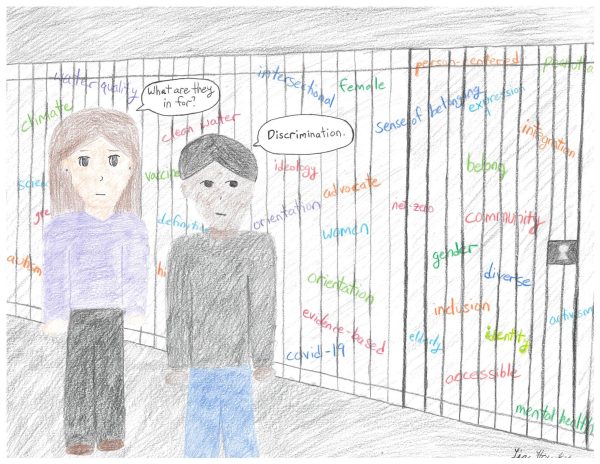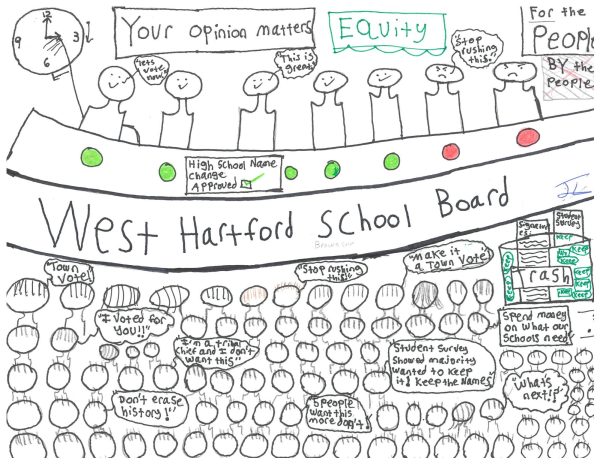Does the Hall Cafeteria Feed Students Enough?
American school lunch: this phrase conjures up the stereotypical image of a plasticky square of “pizza” alongside a carton of chocolate milk. Long criticized for being unhealthy and of bad quality, public school lunches present yet another problem to the students who rely on them: quantity. The cafeteria simply does not supply enough food for students.
The West Hartford Public School District writes on their website that they follow Connecticut nutrition standards for food. The Connecticut nutrition standards, in turn, follow USDA National School Lunch Program (NSLP) guidelines for nutrition standards, including calorie minimums and maximums. Established in the 2013-2014 school year, these guidelines stipulate that over the course of a week, schools must serve a daily average of 750-850 calories to each student. These limits were set in order to balance the need to reduce childhood obesity and improve childhood health while simultaneously feeding children enough to support their growth and energy levels in accordance with the Healthy Hunger-Free Kids Act (HHKA) of 2010.
While well-intentioned, these guidelines do not provide growing students, particularly biologically-male athletes, with enough energy. The federally-created Dietary Guidelines for Americans suggest that the caloric needs for active biological male athletes from the ages of 14-18 (high school students) range from 2800-3200 calories daily. If the maximum daily caloric intake of school lunch allowed by the NSLP guidelines is tripled, the result is 2550 calories per day, falling short of the nutritional requirements of even 14-year-olds (2800 calories) and moderately active 15-18-year-olds (2600-2800 calories).
A total of 687 students participated in sports in the fall and winter season, out of roughly 1525 total students. This means that roughly 45% of the school is involved athletically. 364 out of roughly 762 males participated athletically, meaning that 48% or basically one out of every two males plays a sport, and thus is not receiving the calories they need from school lunch to fuel their day and their sports lives.
When asked whether school lunch is enough, Andrew S. (‘21, Swimming and Diving) said, “No. There just isn’t enough food. Normal meal portions [that come with lunch] aren’t enough so it often forces you to buy like, cookies, or other treats that are not as nutritious as normal food usually is,” adding that, as an athlete, he doesn’t “need the extra sugar” from snacks bought alongside lunch, but he “doesn’t have any other choices.”
When faced with the same question, Sam A. (‘22 – Cross country/track) expressed the same sentiment, arguing that “many lunches give far fewer calories than especially athletes [need]. I think that some of them give more than others but none of them give enough…to sustain [a student] for exercise.” He also suggested that the school “should push to try to make the fruits and vegetables more appealing.”
A promising alternative to the served hot and cold lunch options is the salad bar— earlier in the year it was made self-serve. Students could grab a plate and fill it with as much lettuce, spinach, chicken, cheese, eggs, and other assorted toppings as they wanted. As well as being healthier than traditional public school fare, the self-serve factor allowed hungry athletes to forego hunger later in the day and be energized for optimal athletic performance. However, after a few short months, the salad bar reverted back to its previous state, prepackaged in plastic containers with a limited (and small) amount of food available. The Hall Cafeteria Manager said that the change was due to Coronavirus-related worries of contamination from the self-serve utensils. Additionally, whenever students use the salad bar, they are supposed to take a minimum of two ounces of protein. With the self-serve salad bar, students took salad without protein, thus evading the rules. With the prepackaged system though, students cannot pass the register without two ounces of protein in hand.
Due to the highly federally-regulated nature of the Hall cafeteria, there is not much to be done on a local level. That being said, there are certain steps that should be taken to increase the health and energy level of Hall’s students, especially athletes. Once the Coronavirus epidemic has ceased or lessened to a great degree, the salad bar could return to being self-serve. Additionally, instead of offering snack foods like chips and cookies at the checkout line, the cafeteria could increase fresh fruit options. The elimination of the omnipresence of junk food would remove any temptation of spending money on unhealthy options.





